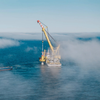U.S. Export Reform: New Year, New Rules
Export Reform Brings New Compliance Obligations to the Shipbuilding Supply Chain
Early in the coming year, the U.S. export control regime governing the shipbuilding supply chain will undergo a sea change with the implementation of export reform in the naval and marine categories of the U.S. Munitions List (USML) and the Commerce Control List (CCL). Reforms affecting the aerospace industry(1) were published April 16, 2013(2) and took effect October 15 of this year, and the final rules published on July 8, 2013 for the naval and marine categories will take effect on January 6, 2014. As previously reported,(3) one of the goals of the export reform initiative is to protect the nation’s “crown jewels” with higher export control walls while removing restrictions on less important items and technologies in order to promote, among other things, interoperability of U.S. and allied forces. All sectors of the shipbuilding supply chain must adjust their export compliance procedures to conform to the new rules, but the naval shipbuilding supply chain in particular will face considerable upheaval as it becomes subject to two separate export control regimes – both the Export Administration Regulations (EAR), which include the CCL, and the International Traffic in Arms Regulations (ITAR), including the USML, with which most shipyards and suppliers have become familiar.
Each set of final rules published as part of the export reform process includes revised USML categories (published by the U.S. Department of State, which, through its Directorate of Defense Trade Controls (DDTC), implements the ITAR) as well as conforming revisions to the applicable CCL categories (published by the U.S. Department of Commerce, which, through its Bureau of Industry and Security (BIS), implements the EAR). In addition, the final rules typically contain new definitions, and these may have a broader application not limited to the revised USML and CCL categories contained in the particular rule with which the new definitions are published. For example, the aerospace rules that became effective on October 15 incorporated the newly defined term “specially designed” in both the ITAR and the EAR – definitions that will apply to all revised USML and CCL categories – as well as numerous other transitional provisions affecting all categories of reform, such as transitional use of existing authorizations. The naval and marine rules scheduled to come into effect on January 6, 2014 affect USML Categories VI (Vessels of War and Special Naval Equipment) and XX (Submersible Vessels and Related Articles), as well as Category 8 of the CCL, to which a new “600 series” of Export Control Classification Numbers (ECCNs) has been added to accommodate items transferred from the USML.(4) However, while the principal naval and marine categories are USML Categories VI and XX and CCL Category 8, it should be noted that effective January 6, 2014, amendments to Category 9 of the CCL will affect gas turbine engines for surface vessels, and the revised Category XIII will contain controls related to ship signature management. In addition, as in the past, other items incorporated in vessels will continue to be covered by various other USML and CCL categories (e.g., radar systems, which are covered by USML Category XI or CCL Category 6, depending upon whether they are specifically designed for military applications). The current rules, to the extent not amended, will continue to apply to categories not yet amended as a result of export reform.
Also included in the new DDTC rules are revised definitions of “surface vessels of war” controlled under USML Category VI and “submersible vessels” controlled by USML Category XX. If a surface vessel is specially designed for military use but not covered by the new definition, under revised Section 121.15(b) it will be subject to the EAR under ECCN 8A609. Likewise, under revised Section 121.14(b), submersible and semi-submersible vessels not covered by the new definition will be subject to the EAR under ECCN 8A620. Both Categories VI and XX cover developmental vessels funded by the Department of Defense, subject to certain exceptions, as well as specially designed parts and components therefor.
In addition, the new “600 series” will incorporate controls on test, inspection and production equipment and related commodities specially designed for the development, production, repair, overhaul or refurbishing of both items enumerated in ECCNs 8A609 and 8A620 and items enumerated in Categories VI and XX of the ITAR. This is a new development for the naval shipbuilding supply chain in particular, as the ITAR traditionally has not controlled means of production.
The DDTC Final Rule further revises USML Category VI to abandon ITAR controls on most generic parts, components, accessories, and attachments specifically designed or modified for Category VI surface vessels (with the exception of developmental vessels, as discussed above) in favor of a positive list of parts and components that in the U.S. Government’s view continue to merit USML control. That positive control list, found in revised USML Category VI(f), includes only nine types of parts and components. All parts and components not specifically enumerated on the USML will move to the new “600 series” in Category 8 of the CCL. The approach taken in Category XX is somewhat different, in that all “specially designed” parts and components, including those for developmental vessels, will remain ITAR controlled.
The starting point for compliance with the new rules will be to determine the classification of the vessel under construction. Suppliers will find that they must implement separate compliance systems for similar products, depending upon the platform into which the products are incorporated.
Take, for example, a systems integrator who is supplying foreign sourced heating, ventilation and air-conditioning (HVAC) systems for the LCS as well as for unarmed underway replenishment ships. As littoral combat ships are enumerated in the new ITAR definition of surface vessels of war, the LCS will continue to be ITAR controlled. The HVAC system, on the other hand, while covered by the current USML Category VI(f) as a “specifically designed” component, is not found on the list of nine parts and components that will remain subject to ITAR control under the revised Category VI(f), nor is it enumerated in any of the other paragraphs of Category VI. Consequently, the HVAC system moves to the CCL and is classified under ECCN 8A609. The applicable sub-category under ECCN 8A609 will drive the restrictions on the HVAC system and related technology. In comments contained in its Final Rule published July 8, 2013, BIS explicitly declined to include HVAC equipment in the most permissive sub-category (8A609.y, which is subject to export licensing requirements for only a limited range of destinations), thus relegating HVAC systems for the LCS to ECCN 8A609.x (covering “specially designed” parts, components, accessories and attachments, which requires licensing for all countries except Canada). Related technology therefore will be controlled under ECCN 8E609. However, technical data related to the LCS itself and related defense services will remain controlled under Category VI(g) of the ITAR. Thus, while the integrator’s relationship with its foreign supplier (and any foreign employees) will remain subject to ITAR licensing requirements to the extent technical data exchanges involve information directly related to the LCS itself, EAR requirements also will apply to the extent that technical data exchanges relate to the HVAC system or controlled test, inspection and production equipment. Depending upon the nationalities of the foreign supplier and foreign employees and whether license exceptions may be available, the EAR will impose an additional layer of licensing requirements that the integrator will have to comply with. On the other hand, if the same systems integrator also is supplying HVAC systems for unarmed underway replenishment ships, transfer of the ships from the USML to the CCL will make both the ship and its components subject to the EAR. However, while this may simplify export compliance for the integrator as to this particular program, integrator personnel working on both the underway replenishment ship program and the LCS program will find themselves subject to two different sets of export compliance procedures when communicating with the foreign supplier. As noted above, ECCN 8A609.x will “catch” “specially designed” parts, components, accessories and attachments moving from the ITAR to the EAR. Application of the EAR definition of “specially designed” to each part or component will be required to determine whether the part or component is captured by ECCN 8A609.x (or any other ECCN that utilizes this term). All parts, components, accessories, attachments and software “for use in or with” a commodity or defense article enumerated or described on the CCL or USML will be considered “specially designed” unless “released” under subsection (b) of the definition (which is found in Part 772 of the EAR). Note that each of the terms parts, components, accessories, attachments and software is itself defined in Part 772 of the EAR. Subsection (b) lists six categories for exclusion or release, each of which should be examined in turn.(5) For example, items for which a commodity jurisdiction determination or commodity classification ruling has been obtained assigning the item to a different classification will be excluded from ECCN 8A609.x, as will fasteners, washers, spacers, insulators, grommets, bushings, springs, wires and solder. Moreover, a part or component that also is used in the production of a commercial vessel classified under previously existing ECCN 8A992 also will be released. In addition, “specially designed” items specifically enumerated in ECCN 8A609.y (such as galleys or filters and filter assemblies) will be excluded from the more restrictive “.x” sub-category.
The ITAR equivalent of the “specially designed” definition must be applied to determine if Category VI or XX paragraphs capture certain items (e.g., “specially designed” hulls or superstructures for Category VI vessels or “specially designed” electric motors for Category XX submarines). For “catch all” parts and components sub-categories, application of the definition will be similar to application of the EAR definition discussed above. In addition, as when applying the EAR definition to end items, the focus will be “properties peculiarly responsible for achieving or exceeding the controlled performance levels, characteristics, or functions.”
Long anticipated, export reform will require renewed focus and expenditure on export control compliance by shipyards and their suppliers. Those who have not done so already should begin with a review of their programs to determine whether the vessels they are building are ITAR controlled or subject to the EAR. Suppliers at all tiers should ensure that these determinations are made in consultation with the shipyards who are their ultimate customers. Once jurisdiction over the vessel has been established, an analysis of the classification of each item supplied must be undertaken, together with an analysis of related technology or technical data and means of production. Export activities related to ITAR or EAR controlled items then must be conducted according to the applicable compliance procedures. This includes everything from appropriate marking of technical data to obtaining license authorizations for technical data exchanges with foreign suppliers and foreign national employees. Most companies will have to update their existing procedures at least to some degree to conform to the new ITAR rules, and companies who focus exclusively on the naval shipbuilding supply chain will have to become familiar with the EAR as well as the ITAR and develop new EAR compliance procedures to cover export activities related to items and technology no longer subject to the ITAR.
Barbara Linney is a member of the Washington D.C. law firm Miller & Chevalier and has been advising clients on international issues for over 20 years.
e: [email protected]
Abigail Cotterill is an associate at Miller & Chevalier focusing on export controls and economic sanctions.
Kevin Miller is an International Trade Specialist in the firm’s International Department.
This article reflects developments through November 19, 2013, the date of submission for publication. The views expressed herein are those of the authors, do not necessarily reflect the opinion of the firm or other members of the firm, and should not be construed as legal advice or opinion or a substitute for the advice of counsel.
1 Amendments to USML Categories VIII (Aircraft and Related Articles) and XIX (Gas Turbines Engines and Associated Equipment) and related amendments to Category 9 of the CCL.
2 Various amendments to the DDTC and BIS rules published April 16, 2013 were published on October 3, 2013 and additional conforming amendments to the EAR were published on October 4, 2013.
3 Our previous reports on the export reform process can be found in the August 2012 (“Export Control Reform in the Shipyard: Will it Simplify Regulation of the Supply Chain?”) and May 2011 (“U.S. Export Control Reform: What It Means for Shipyards”) editions of Maritime Reporter.
4 Also scheduled for implementation on January 6, 2014 are revised USML Categories VII (“Ground Vehicles”) and XIII (“Materials and Miscellaneous Articles”), as well as accompanying amendments to Category 0 of the CCL, and amendments to Category 9 of the CCL related to gas turbine engines for military vehicles and surface vessels.
5 In the case of the HVAC system example discussed above, none of the bases for exclusion applied.
(As published in the December2013 edition of Maritime Reporter & Engineering News - www.marinelink.com)











